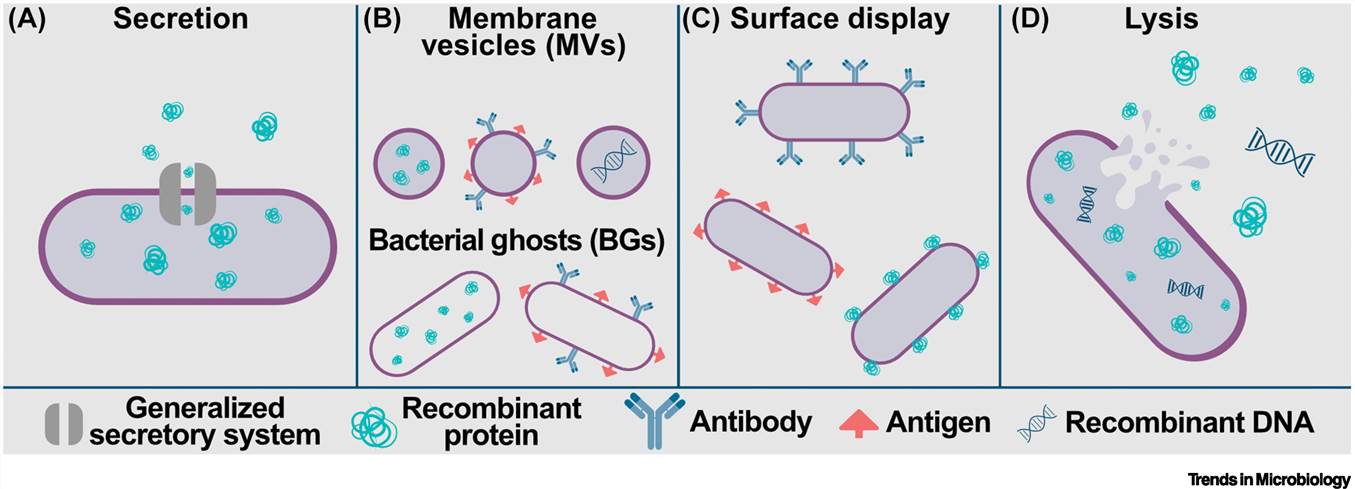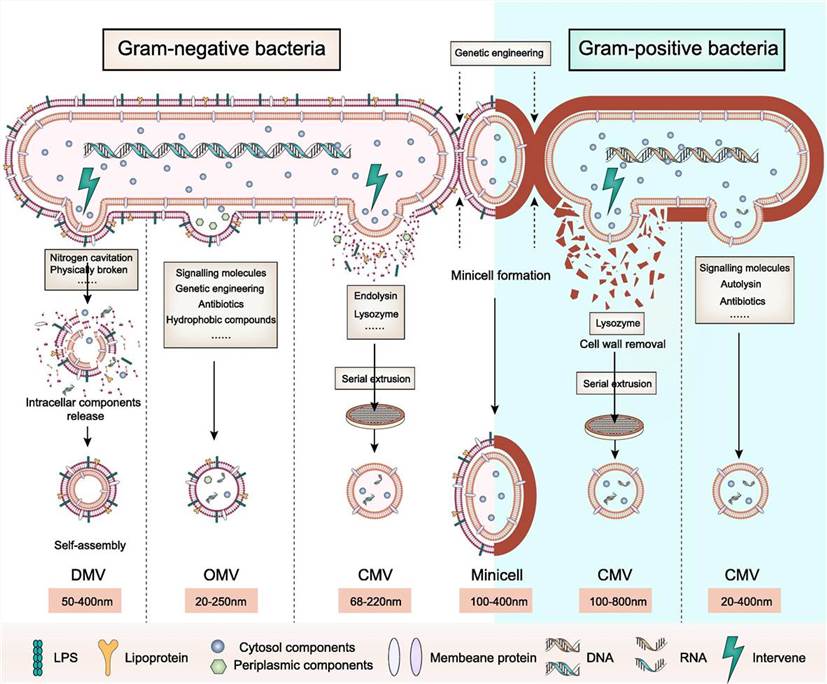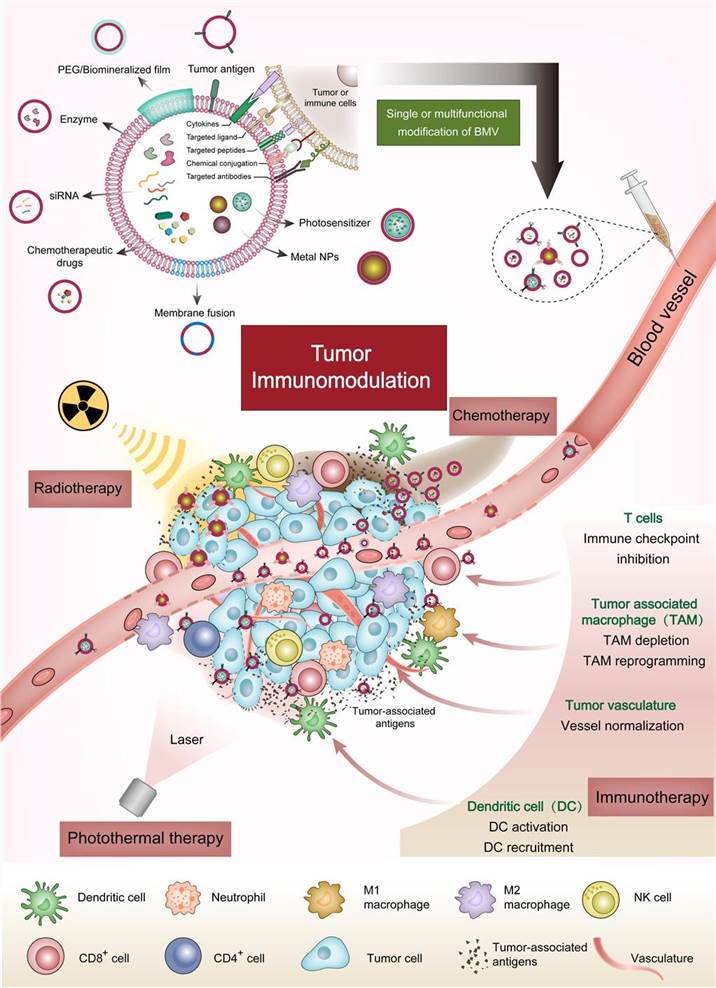Bacterial-Based Nucleic Acid Delivery System Development
InquiryCD Formulation excels at harnessing the power of synthetic biology and genetic engineering to engineer bacteria for the delivery of nucleic acids. Our bacteria-derived vectors have proven to be effective bioengineering tools that promote the targeted secretion and release of nucleic acids. In addition, we can also use bionic nanoparticle encapsulation technology to achieve the targeting and controlled release of nucleic acid drugs.
Bacteria-Based Drug Delivery Vehicles
Through genetic engineering and synthetic biology, bacteria can be transformed into vehicles capable of producing and delivering therapeutic molecules. These vehicles can be administered orally or intranasally, exploiting the immune-stimulating properties of probiotics and attenuating pathogenic bacteria. The use of secretion, membrane vesicles, surface display, and lysis as modes of delivery presents distinct advantages and challenges. With ongoing advancements and clinical trials, bacterial-derived vehicles hold great promise for targeted and efficient drug delivery.
 Bacterial-derived therapeutic delivery models (Alexander L.M.; van Pijkeren J.P. 2023)
Bacterial-derived therapeutic delivery models (Alexander L.M.; van Pijkeren J.P. 2023)
How Do We Use Bacteria to Deliver Nucleic Acids?
- Customization of Bacteria Directly as Drug Delivery Vehicles
Customizing bacteria as drug delivery vehicles has unique advantages in the fields of DNA vaccines and siRNA delivery. CD Formulation exploits the natural properties of bacteria, such as their ability to colonize tissues and interact with the immune system, to enhance the targeting of gene drug delivery.
We can engineer bacterial strains to secrete or surface DNA vaccine antigens intracellularly or extracellularly, further optimizing the delivery process.
To achieve efficient delivery of siRNA, we carefully optimized the bacterial siRNA secretion and release mechanisms.
In addition, we can help clients explore the suitability of delivery routes such as oral and nasal administration.
- Bacterial Membrane-Coated Biomimetic Nanoparticle Development
By isolating and purifying bacterial membranes, we control the origin of bacterial membrane vesicles (BMVs), creating a biomimetic outer layer that mimics the natural surface properties of bacteria. Nucleic acid-based vaccines/drugs are encapsulated in suitable nanoparticles for fusion with bacterial membrane vesicles. Through rigorous characterization, optimization, and functionalization, we tailor these nanoparticles to achieve efficient cargo delivery and desired therapeutic outcomes.
Types of BMVs We Can Develop
 Production of various BMVs (Long Q.; et al. 2022)
Production of various BMVs (Long Q.; et al. 2022)
OMVs: OMVs are approximately 20–250 nm in size and originate from the outer membrane of Gram-negative bacteria (G-). Because of its nanoscale structure, rich outer membrane components and strong genetic engineering operability, it is the most studied bacterial vesicle.
CMVs: CMVs are approximately 20–400 nm in size and are single-membrane vesicles formed from the plasma membrane of Gram-positive bacteria (G+). Controllable in size and capable of inducing immunity.
DMVs: DMVs are approximately 20–400 nm in size and contain intact inner and outer membrane components of bacteria. Safe and retains immunogenicity.
Applications of Our Bacterial-Based Nucleic Acid Delivery System
 Application of BMVs in tumor therapy
Application of BMVs in tumor therapy
(Long Q.; et al. 2022)
We bioengineer probiotic bacteria to express vaccine antigens and stimulate mucosal immunity through oral/nasal administration.
By encoding tumor-targeting and immune stimulating factors, our bacterial systems deliver combinatorial immunotherapy locally to tumors.
We have the metabolic and genetic engineering expertise to combine bacterial targeting with controlled nucleic acid release, aiming to deliver genetic medicines safely and effectively.
Advantages of Our Bacterial-Based Nucleic Acid Delivery System Development Services
- Bacteria possess inherent mechanisms for the efficient delivery of nucleic acids, ensuring high bioavailability and increased therapeutic efficacy.
- By engineering bacteria as delivery vehicles, we can achieve precise targeting of nucleic acids to specific cells or tissues.
- By incorporating immunogenic sequences and utilizing the immune-stimulating properties of bacteria, we can enhance the immunogenicity of the delivered nucleic acids.
- Our diverse bacterial strain library provides customers with flexible options and combinations for drug delivery system selection and administration route selection.
By leveraging our expertise in bacterial programming and biomimetic nanoparticle technologies, we aim to realize the promise of personalized nucleic acid medicines. Our services help clients transform nucleic acid therapies from concept to reality. If your research could benefit from our bacterial-based nucleic acid delivery solutions, please contact us!
References
- Alexander L.M.; van Pijkeren J.P. Modes of therapeutic delivery in synthetic microbiology. Trends Microbiol. 2023, 31(2):197-211.
- Long Q.; et al. Engineered bacterial membrane vesicles are promising carriers for vaccine design and tumor immunotherapy. Adv Drug Deliv Rev. 2022, 186:114321.
Related Services



 Bacterial-derived therapeutic delivery models (Alexander L.M.; van Pijkeren J.P. 2023)
Bacterial-derived therapeutic delivery models (Alexander L.M.; van Pijkeren J.P. 2023) Production of various BMVs (Long Q.; et al. 2022)
Production of various BMVs (Long Q.; et al. 2022) Application of BMVs in tumor therapy
Application of BMVs in tumor therapy